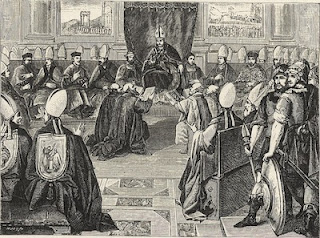Richard's eldest child, Richard, would succeed his father.
Alice, born c.1003, lived until she was 35 and bore a few children to Count Reginald I of Brittany (another Brittany link).
Robert was born 22 June c.1005-7. Known also as Robert the magnificent, he would have his own chance to be duke.
William entered Fécamp Abbey and died young.
Eleanor was married to Count Baldwin IV of Flanders. Their granddaughter Matilda would marry William the Conqueror.
Matilda became a nun at Fécamp.
After Judith's death in 1017, Richard II took a second wife, Poppa of Envermeu. Their children were Mauger, who became archbishop of the Rouen, the seat of the Normandy administration, and William, count of Arques in northwestern France.
When the eldest son became Richard III of Normandy in 1026, his brother Robert attempted a coup. Robert was not happy with only having a province to rule (Hiemois, now called Exmes) that his father had given him shortly before dying. Robert's rebellion was unsuccessful. Richard captured him, but released him on condition of an oath of loyalty. The thing done, Richard dismissed he army, returned to Rouen, and died. An extraordinarily convenient death, so of course there was talk of poison.
Richard had been married to Adela, a daughter of the king of France, but they were childless. He did have children by an unknown woman or women. A son became a monk at Fécamp, a daughter, Alice, married the viscount of Bayeux. They were not suitable for the royal succession.
Whatever the case, in less than a year since he took the throne (about 49 weeks), it passed to none other than Robert, about whom we will have things to say next time, including a mention of his well-known son.



























